“The impossible could not have happened, therefore the impossible must be possible in spite of appearances.”
Hercule Poirot, Murder on the Orient Express, Agatha Christie
“The impossible could not have happened, therefore the impossible must be possible in spite of appearances.”
Hercule Poirot, Murder on the Orient Express, Agatha Christie
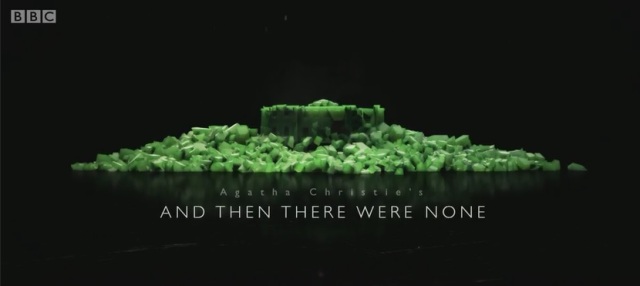
And Then There Were None
Adapted by Sarah Phelps for the BBC
First shown 27 December 2015
We open, again, with Vera. As the cold draws in on the island, we see her by another beach, playing with her lover Hugo and a little boy. The story of Then verses Now is told entirely through the colours of each.
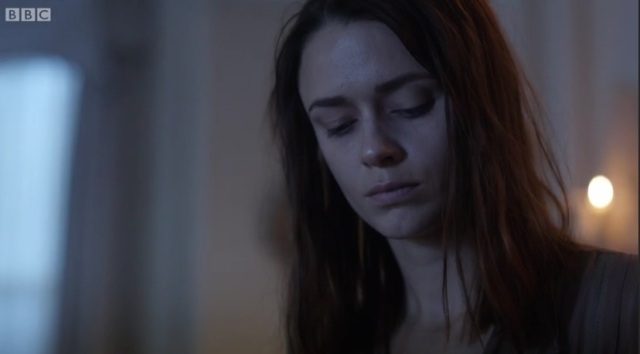
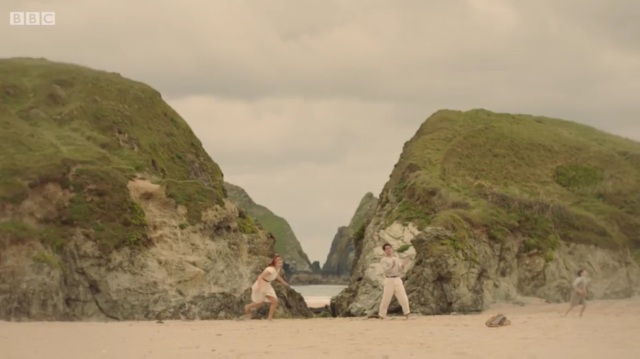
Watching Wallander, Vera, Luther or any other deliberately nihilistic series, it can be difficult to care about the characters. When every day is shot in cold greys, browns, or muddy greens, we know that every day in their world contains the same gloom, so why care? Similarly, in Poirot, Midsummer Murders or Marple, everything is bright or shot in pastels, so you never really feel any sense of threat. And Then There Were None makes us feel the terror of the central characters because we know what they have lost, we have a sense of the world they have been taken away from and consequently the horror they are dealing with now.
It can’t be a coincidence that, once inside the house, the decorations are Nouveau moving towards modern and, other than Mrs Roger’s glasses, nobody is dressed in a way that would look out of place on a modern high street. Unlike in Christie’s original, characters take drugs, have (extra-marital) sex. Some are gay. “Shit the bed,” mutters Blore. We see, through Mrs Rogers, that being working class in this age was tough. We see, through Vera, that being a woman was tough. Flashback-Hugh and flashback-Cyril are dressed in standard Christie get-up and pipe away in RP, seconds away from shouting ‘crumbs’, but in the house, we see characters with concerns and values similar to our own. And so we emphasise with them far more.
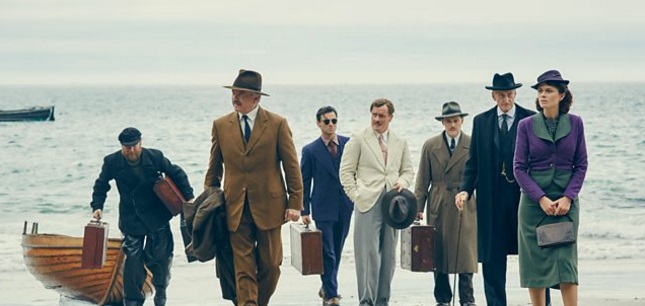

This has good points and bad points.
Lily James, before playing Natasha Rostova in War and Peace, pointed out that from a 21st century perspective it is difficult to understand a relationship, much less an engagement, where neither party would see or be in contact with the other for months on end, possibly after only having met a few weeks previously. Values change. Would Hugo and Vera really have slept together before marriage, much less outdoors?! Probably not: but showing this on screen does make their relationship into one that is familiar to the audience. All we need to take away from this is that there was a significant relationship in Vera’s past, and precisely how this is shown doesn’t really impact on the main plot.
The Lombard / Vera flirtation is rather more difficult to justify. The taking cocaine makes sense: the theme of Christie is that people are the same, throughout time, everywhere – it fits with the theme of the original. However, with four survivors left, two going into a room with each other…it means that they have decided to trust each other. That is unsubtle.
Talking of unsubtle, we come to Blore. Whilst it is amusing to have him be wearing a woman’s sunhat and cosying up to Armstrong when Lombard and Vera are dancing, the character as written in the script veers too close to parody. Unlike with the scripted Emily Brent, where the character arc at least makes logical sense, it is difficult to see exactly what about his repressed sexuality made him want to beat an innocent teenager to a pulp.
The saving grace is Burn Gorman. We see Blore, in flashback, sitting in a cell with an almost offensively effete young man. Blore, the friendly neighbourhood bobby, tells the lad off and says not to do it again, because “it’s no fun for you lot in the nick”. His soon-to-be victim, who is all leg, ears, and looks all of about sixteen, is frozen in relieved shock before he says “thank you”. We’re in the flashback world of Christie-land sterotypes, and everything is going to be okay.
And then Blore’s hand slams into the boy’s chest, and he looks him in the eye and hisses
“That is what I should have done. That is what I should have done.”
Then he looks around, and closes the door of the cell, shutting out the camera, which sees no more. Shortly afterwards, he dies and, thanks to Burn Gorman, chills go up the spine.

And then, with only Lombard and Vera left, they go down to the beach and discover Armstrong’s body. Logically, this makes one of them the murderer.
It really is a pity that the adaptation succumbed to the convention of forcing a romance between Lombard and Vera. In the book, their lines after the discovery of Armstrong’s body make clear that they know that they are the only two left on the island. They know that everyone else is dead. They both think the other is the murderer – but they both know that it is so obvious that it doesn’t need to be said outright. Their spoken lines are ambiguous, and Vera gets her shot in first.
But the way it’s played on screen – unavoidably to a degree, because printed lines can be read a number of ways but spoken lines only one – is that Vera, having gone to pieces entirely, waves the gun at Lombard because she thinks he might have done it. Lombard holds his nerve and thinks that something else is going on and is trying to reason with Vera. Vera, who by now doesn’t know what to believe or which way is up, shoots once as a warning, almost by accident. Horrified by what she has done, she then fires again. Lombard dies a hero, and we feel sorry for the emotional wreck that is Vera: it makes both characters too sympathetic at this stage in the game.
Interestingly, out of all the inhabitants of the island, only Lombard and Wargrave accept their true nature as amoral psycopaths. Lombard doesn’t care if he kills someone for his own gain, but there is an honest humanity to him that the other characters lack. There is genuine compassion in his lines when he looks down at Blore’s body – impossible to imagine from Vera or Armstrong, who only care about themselves. This compassion to someone not in his way is entirely believable. Trying to reason with someone who logic dictates is the murderess? Less believable. And he dies.
And then Vera returns to the house, to be met by…Wargrave. Even knowing the outcome, this is still shocking.
The clinical dispassion of Wargrave in the book turns far nastier here. They show Vera, desperately, pleading for her life. The writers are trying the same trick as they did with Vera and Lombard on the beach as somehow, despite everything, the audience are still hoping that someone will get out alive.
“Stands the church clock at ten to three?
And is there arsenic still for tea?”
What makes And Then There Were None interesting is the darkness, the fact that everything is not okay in the end. Unlike the rest of the works of Christie, it’s a forerunner of nihilistic crime – the stories where there is no detective to arrive on the scene and make everything okay. People do not die cleanly, but are raped, beaten, trussed up in body bags or, like Blore’s victim, beaten to a bloody pulp before our eyes. The genius of the adaption is to show the world of traditional Christie through Vera’s flashbacks, the sunlight, sparkly sunglasses, bright red lipstick, contrasting always to the torture the characters are undergoing on the island.
And, unlike the type of Christie that rests on the same-ness of human nature, despite the common values that the adaption forces on them, all of the characters in And Then There Were None are products of their time. Lombard murdered 21 men and got away with it because they were not white. Blore is repressed, Lombard a sexist. Vera kills because there is no other way to be with the person she loves.
And this is just the murderers. Emily Brent’s maid dies because she was poor, powerless, cast out by society. General MacArthur’s wife: be left on the shelf, a social outcast, or marry a dull old man she did not love. Blore’s victim is killed because he was gay. Wargrave hangs men and women because he can. Mrs Rogers is forced by her husband to abet murder. Dr Armstrong’s victim dies because a nurse cannot contradict a doctor.
Again and again the point is hammered home: if you were working class, female, gay in 1920s England it was a bloody raw deal.
If every Christie were like And Then There Were None then Christie would not be an ensuring success nowadays. It would not be escapism, just raw reality. The story is unlike anything else that Christie ever wrote, barring the less than successful Endless Night, and that is a good thing.
What makes And Then There Were None different to modern viewers is not the darkness of the story: we’re all used to gore and horror. Instead, the chill comes from the bloody, visceral terror seeping in to a setting that we know as safe. It’s like seeing torture and rape in an episode of Midsommer Murders.
And it works.
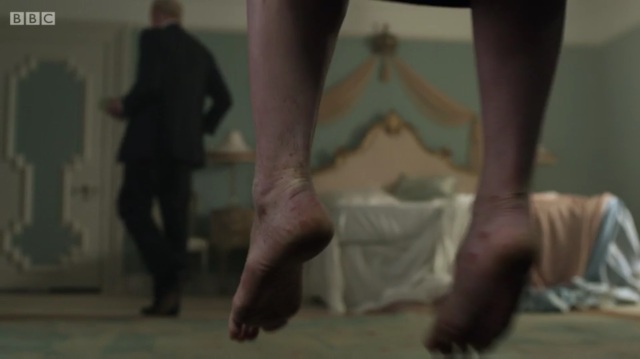

And Then There Were None
Adapted by Sarah Phelps for the BBC
First shown 27 December 2015
As the ‘Previously On’ teaser begins, we come back to Soldier Island as the victims do. We’re left in no doubt of the adaptation’s status as ‘thriller’: the sinister music, the quickly cut scenes, the final shot of death.

The adaptation in many ways brings out elements that in the book were under the
surface. To put it bluntly, everyone on television is a lot nastier. Armstrong’s sneering
dismissal of Vera is unpleasant to watch as he spits out the line:
“Miss Claythorne, I warned you against becoming hysterical”

– but it’s utterly believable as extension of the weak, overly defensive character we see in the book.
This has good and bad aspects. It’s part of the medium that television forces interpretations onto the viewer, whereas reading the book we can make up our own minds.
“Rogers, did you take away any of these figures?” is a very simple line but can be anything in print: investigatory, quizzical, conversational, interrogatory, aggressive. On television, an actress can only play it one way – and the way chosen this time is near-panic. It’s a valid interpretation, but does make everything more black and white.
But there are good sides to this. The 20s attitude to women, the working class, is unspoken in the book. An adaption made in the 21st century lets us see quite how nasty this could be – worth remembering next time we snuggle up to a cosy rerun of Poirot.
“Who the hell do you think you are? I’m a doctor, and you’re just a secretary” snaps Armstrong. “It was dreadful news about Mrs Rogers,” Miss Brent says briskly to the recently widowed husband, “she was a wonderful cook”. Everyone looks on to injustice, and says nothing.
The bad side is that putting all of these extra interpretations into the mix, and making quite a lot of subtexts into text, only mostly works. For one thing, the removal of the shades of grey from many of the characters makes it difficult to get emotionally involved with the fate of anyone: they’re all so unappealing. Even General MacArthur, the most at ease with his fate and least malevolent, is still defined by his selfishness: he doesn’t mind death because he doesn’t have anything to live for. It never crosses his mind that whilst heis done with life, the same might not be true of the others, especially the far-younger Vera, Blore and Lombard. For another, both MacArthur’s and Lombard’s
treatment of Vera, the former patronising, the latter predatory, means that she starts the story already two steps away from hysteria. Tension has to slowly build or rise and fall. If it maintains the same pitch for too long the audience get bored.
Additionally, the sad fact is that both Rogers and Mrs Rogers aren’t very successful characters. Through them, we learn that it’s a cruel world and the cast are cruel people by the way the rich characters treat their social inferiors. It doesn’t leave very much room for
either Rogers or Mrs Rogers as people. Arguably there’s not much the adaptation could have done about this as they’re both offed pretty early on, but then the same could be said of Marston yet Douglas Booth crams a lot into about five minutes. It’s unfortunate that, after making some much of their lot as servants, they are ultimately in the adaptation only to serve a dramatic function.
And then we come to Miss Brent.

It’s been mentioned earlier that the original version of the character won’t wash here, simply because Miranda Richardson is far too attractive to play the character as written in the book. So instead we have to have a different motive. And the one we get is that she’s a repressed lesbian.
It’s not that it isn’t a valid interpretation, and it is good when adaptations do new things. It’s slightly disappointing that, for more than one character, what was a complex set of motives in Christie’s original boils down to ‘sex’ when adapted for TV.
This is also true for the Lombard and Vera story. And it was probably inevitable that Aiden Turner was going to take his top off at some point. The problem is that, as we’ve seen, the script has gone all this way to emphasise how the social barriers of class and gender remain in place despite everyone dying left right and centre. We see Rogers
making the breakfast after the death of his wife, then Vera being the one to deal
with lunch as the only woman left alive, and we’ve seen how the expectations are so built-in to this society that no-one for one moment questions this.
And then we also have Lombard wandering around shirtless in front of the ladies. Not that the character is really one to care, but you would expect someone to say something at this point because the rest of the characters have not yet broken down completely.
[An aside: Philip Lombard, let’s remember, is on the island because he killed a group of men, 21 in all. When Vera asks him about it, we get this exchange.
“Did you really kill all those men?” “Yes, Miss Claythorne, I did. And more.”
…and then he keeps going on about wanting to kill his host and make U N Owen number 22. Was he lying or can’t he count?]
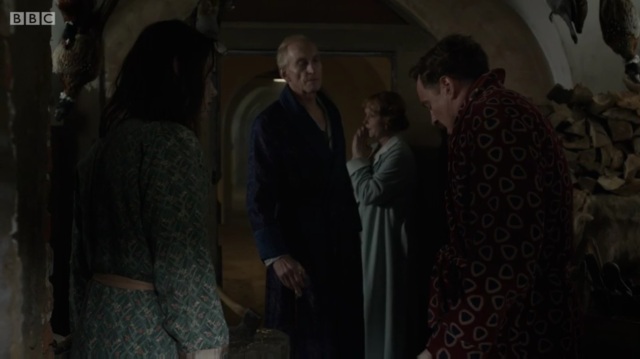
In a sort-of defence, the whole thing is not exactly sexed-up. Other than Lombard and
Marston, for whom it is in character, nobody looks good. Wargrave, Armstrong and MacArthur are nondescript, Vera is downright dowdy. We see characters greasy-haried, in dressing gowns. There is nothing sexy about watching a panic-stricken, half-naked Lombard realise that the gun has gone missing: it just shows us that he is in disarray both
emotionally and physically. And you would certainly not get the line ‘Now, let’s wash the guts off the stairs’ in Poirot.
So when, as the characters search all the bedrooms following the disappearance
of the gun, we get a Romantic Moment between a dressing-gown clad Vera and Lombard – who, slightly less explicably, still hasn’t put a shirt on – we can rest easy in the
knowledge that there’s definitely Dramatic Justification.
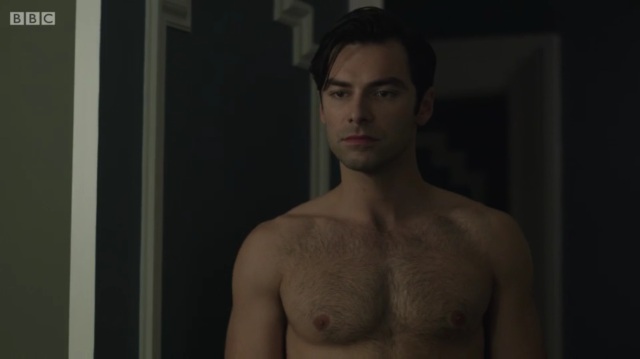
As always, spoilers ahead.
..
….
……..
…………….
2. And Then There Were None
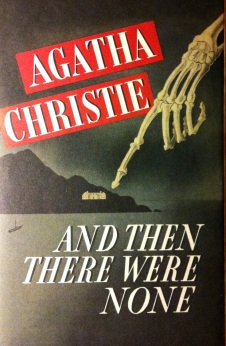
In one of the best thrillers of all time, ten people are lured to an island by the mysterious ‘U.N.Owen’. All of them have something to hide. And then they begin to die…one by one. Eventually they realise that U.N.Owen is one of the ten – and he or she intends to kill them all.
The island is a mile out to sea. Thanks to a storm, they can’t signal for help or swim back to the mainland. All they can do is wait for the inevitable…
…damn convenient storm, isn’t it?

And Then There Were None
Adapted by Sarah Phelps for the BBC
First shown 26 December 2015
The nation sits back on Boxing Day, stuffed full of turkey and chocolate, to
watch nasty, brutal murder. Classic stuff.
And Then There Were None is a rarity. It does not take place in cosy Christie-land, where the church clock chimes three as arsenic is served for tea. There are no glamorous parties, no girls with shingled hair. The key to Christie’s enduring appeal is partly escapism. The reader wants to be part of the settings of Death on the Nile, Murder on the Orient Express, or The Body in the Library – seeing the pyramids, drinking cocktails in the dining car, having afternoon tea with the Bantrys. And there is an essential safety to Poirot or Marple, or to any of the novels with a one-off hero or heroic young couple. It’s the same logic as Shakespearian tragedy, and the detectives play the same role as Fortinbras in Hamlet or Albany in Lear. There is disturbance (the murder), followed by uncertainity and chaos. Then our heroes turn up and order is restored: the murderer is caught, possibly the Young Lovers get together, and things carry on as they always have been.
And Then There Were None closes with everyone dead and a houseful of bodies.
Any adaptors set themselves a challenge. An inferior story can be rescued by nice costumes, a few minor rewrites and some featured guest stars. And Then There Were None is already a good story, but a fundamentally unpalatable one: it’s a nasty tale about nasty people, but one that ramps up the tension and sends chills up the spine on every re-reading. To make it more audience-friendly, Christie herself injected a Young Lovers subplot into the first theatre version: a decision that is justifiable to make a feel-good play, but one that hasn’t stood the test of time*. An adaption doesn’t just have to stay true to the appeal of the original, it also has to find something new to say, to do something in its chosen medium (TV, film, play, e.t.c) that couldn’t be done on paper.
So, does it work?

We begin artistically. Shots of waving corn, followed by a close-up of
somebody’s eye. Quick, thrilling cuts introduce us to the characters.
Including the intro, it takes two minutes before we hear a line of dialogue.
For a moment, it seems like classic Christie: sunlight, a beach, a glamorous young girl with vermilion lips. Then we switch to the present day: dark colours, rain, and a thin, haggard girl standing in front of a window, sucking on a cigarette. It’s honestly a shock to find it’s the same person and we know, immediately, that this is not going to be a nice story. This shows us in a matter of seconds what would have taken pages on paper. Even before she enters a grotty office to take the post of secretary on Soldier Island, we already know how far Vera Claythorne has fallen.
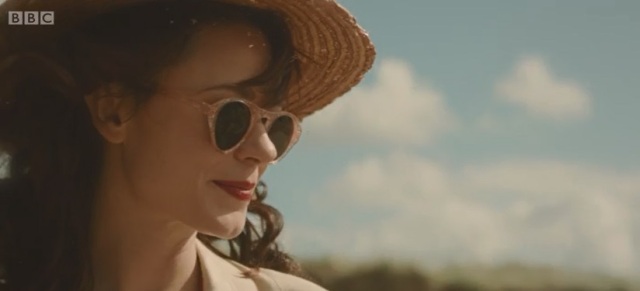
Television can show us things that we can only infer from paper. Actors can bring new aspects to characters, aspects that were only implied in the original. Aside from a few clever visual gags – a close-up of the blind pull on the train makes it look like a hangman’s noose – we get to see things that there wasn’t space for us to be told in the novel. Our introductions to the characters are in little, telling vignettes, with an imperious Wargrave getting Blore to carry his suitcase as they arrive on the island, Lombard’s predatory eyes forcing Vera to move seats on the train, Marston’s car running Dr Armstrong off the road.
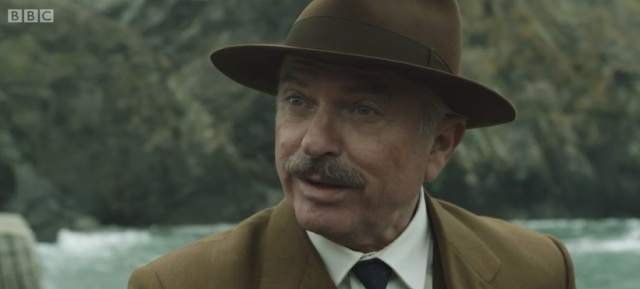
Quite sweetly, we also see a couple of sympathetic moments from General
MacArthur. He’s quite thinly-sketched in the book, but Sam Neill gives him a humanity with his shy, earnest, pompous smile and the quietly chivalric way he chats to Vera after the boatman is rude to her. He even gets a small moment of heroism, staying calm while the others lose their heads as the action heats up.
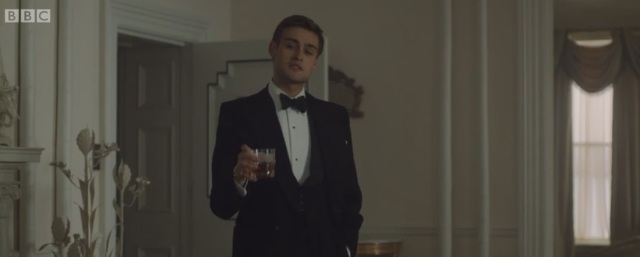
Anthony Marston is another cipher-in-the-book who becomes real on screen. Douglas Booth combines boyish good looks with charming, ruthless narcissim and is easily the most enthralling character in a scene.
Marston ran over two children and didn’t stop. When this is revealed, he asks ‘Who on earth are John and Lucy Coombes?’ with an air of pure bewilderment. A two-dimensional cut-out on paper is transformed into a glossy, arrogant rich boy who talks of ‘simpatico’ great chums, flings himself down on the chairs, leers at Vera, yet through all this maintains an air of childish innocence. His delivery of ‘Let’s be pals‘ as part of his ‘apology’ for running Armstrong off the road is BAFTA-worthy.
It’s an exceptional piece of casting. The same must also be said of Aiden
Turner as Lombard, who somehow manages to be dashing and sleazy at the same time. Lombard is clearly, unapologetically evil but enrapturingly so. Not once but twice we get a male-gaze from his angle directed at Vera. She shrugs it off, but it’s deeply threatening. The narrative makes it clear from the off that everyone on the island is guilty and every action, scene, shot and expression makes us feel part of the unsettling atmosphere.The lighting is cold, as are the big, empty rooms of the house. We see the bloodied bodies of children run over by a car. Wide camera angles mean the large house is made to look tiny against the expanse of the
island, the characters are small on the screen. Lines like “She’s been dead
about 14 hours…tell the others not to expect too much in the way of
breakfast” speak volumes in 19 words.
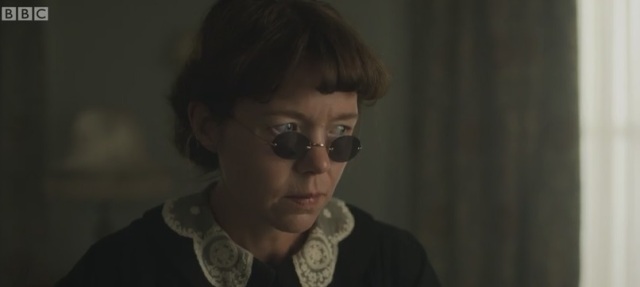
That said, there are some missteps. Anna Maxwell Martin is a lovely looking woman with a rare, aristocratic, almost ethereal beauty. No amount of shaking hands and unflattering glasses will make her suitable for the role of browbeaten, meek, grotty skivvy Mrs Rogers. Emily Brent in the novel is a bitter, sexually frustruated, plain woman with a religious mania.
The unstated backstory in the novel is that Emily Brent found solace in
religious mania and self-righteousness because she was an ugly woman, inside and out, who was unable to attract friends or family: someone who lashed out at the world because the world did not want her. And in this role they cast Miranda Richardson.

With all the acting in the world this doesn’t ring true.
Somehow, Richardson carries the portrayal off – it isn’t the Miss
Brent from the book, but the imperious, high-strung Lady of the Empire is a new and fascinating character in her own right. The same sadly cannot be said of Mrs Rogers. Bowed and scuttling, this portrayal is capital-A Acting and would work on stage. On screen, in close-up, it’s far too unsubtle and quite frankly unbelievable. There isn’t dramatic tension if a character starts the story so close to a nervous breakdown as Mrs Rogers clearly is; there’s nowhere to take the character. Both Mr and Mrs Rogers are too near parody, and you never forget for a moment that these are actors playing parts.
Fortunately, everyone else is so good that, for the moment, it doesn’t really matter.
…
*The flip side of this is that turning a ‘cuddly’ Christie into a cold story
doesn’t work either. The David Suchet Murder on the Orient Express is a case in point. The novel is the high point of cosy Christie: it has a genuinely
moral heart to it and takes place amongst fur coats and cocktails. The
adaption has the cast huddle shivering in a freezing train carriage while sympathetic characters break down and threaten murder, ending with a crisis of faith from Poirot of all people. None of these are inherently bad ideas, they just don’t fit with the theme of the original.
 Agatha Christie, along with her first husband Archibald Christie, was one of the earliest British people to master the art of stand-up surfing.
Agatha Christie, along with her first husband Archibald Christie, was one of the earliest British people to master the art of stand-up surfing.
Martin Edwards, The Golden Age of Murder, HarperCollins, 2015
Obviously, spoilers ahead.
..
….
……..
…………….
3. Murder in Mesopotamia
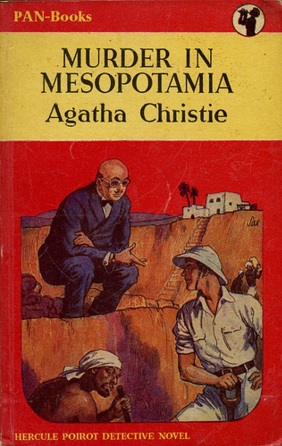
As a novel, Murder in Mesopotamia is interesting for a lot of reasons. For one thing, it’s one of the few Christie’s to use first-person narration: the Hasting novels have it, back when Christie was more consciously mimicking Conan Doyle. As does The Murder of Roger Ackroyd, in which the first-person narration is rather crucial to the plot.
Murder in Mesopotamia would be the same book if it were not narrated. Amy Leatheran, a gentle and practical middle-aged nurse, is no Hastings: we know that she is not staying around for more than one book, nor do we learn anything more about Poirot from her eyes. There really seems no reason for an observer to narrate, other than that it gives a slightly more personal feel to the book than the other, paint-by-numbers Poirots.
Amy Leatheran is asked to join a dig in Mesopotamia by archaeologist Dr Leidner, who is worried about his wife and wants her to be observed by a trained nurse. This is a cue for a lovely array of background details about life on a dig in Mesopotamia: something Christie was familiar with through her second marriage, to archaeologist Max Mallowan. It’s all very realistic and moderately interesting. In the background, we find out about Mrs Leidner’s first husband, a German spy. A week after Amy Leatheran arrives, Mrs Leidner is found dead. Whodunnit?
Her first husband, long thought dead. It then turns out that he was at the dig, in disguise, and Mrs Leidner didn’t recognise him. It stretches belief, but is just about plausible.
And then we find out that his alter-ego was….drumroll…Dr Leidner. Mrs Leidner’s first husband was in disguise as her second and she didn’t recognise him.
Yeah.
Spoilers! Please do not read on if you haven’t read Career of Evil.
…
… …
… … …
… … … …
… … … … …
Throughout the three Cormoran Strike books, we’ve been learning steadily more about Robin Ellacott, his golden-haired secretary. In A Cuckoo’s Calling, she is a fairly bland character. A nice girl, with a nice house, nice family, and a boring fiancée. Working as a temp, she wanders into Strike’s office and stays.
In The Silkworm, Robin grows as a character a little bit more. We see layers that we didn’t know were there, and that she had forgotten about completely. She turns out to be a naturally good investigator, an adept driver, amateur psychologist…slowly, Strike comes to give more of his work over to Robin, until she steadily becomes his partner. We find out that Robin was studying at university, with dreams of working for the police, before mysteriously dropping out. The tensions between her and her accountant fiancée, Matthew, become greater as Robin grows away from him and spends more and more time at the office.
Matthew’s theory is that Robin is in love with Strike. The hours spent at work, the new light in her eyes…We, the reader, don’t see an affair. We see that Robin is simply in love with her job. And, by Career of Evil, she is taking on cases as well as, if not better than, her boss.
Ah, yes. Career of Evil.
Midway through the book, there is a ‘revelation’: a ‘revelation’ that seeks to explain Robin’s claustrophobic relationship with Matthew, why she left university, why such an intelligent, driven woman is working as a temp…
We find out that she was raped as a teenager.
This leaves an extremely unpleasant taste in the mouth.
Almost certainly Rowling’s intention. Career of Evil is intentionally a darker book than its predecessors. We go beyond cartoonish violence into seeing the impact of crime on real life: fair enough that it should involve our main characters.
But with that said, sexual violence has become a cliche in detective fiction: a cheap, easy, gratuitous way to make a story dark or adult. As we are repeatedly told by Strike’s internal narration, it makes Robin into someone whose life has been defined by those twenty minutes.
What Rowling is doing is admirable, but some of the implications are a bit unsavoury.
But, leaving all of this aside, there is an alternative explanation.
We are far from the sunlit, uncomplicated days of Poirot and Marple. To be a detective nowadays, you need some kind of backstory, some kind of motivating trauma. It’s probably quicker to name those who don’t have this, but to give a flavour:
Adam Dagliesh, Tony Hill, Thomas Lynley, Quirke, John Rebus, Lisbeth Salander, Scott and Bailey, Vera Stanhope, Kurt Wallander….Strike himself has his father, his mother, his leg and Charlotte.
When we met Robin originally, she was an archetype: the nice girl with the nice job and boring fiancée, who discovers another, more exciting life and runs headlong into it. The nearest parallel in popular culture is probably a Dr Who companion: it’s a typical ‘gate to another world’ story, except that the world Robin discovers exists (sort of) in real life. The cliche of past trauma actually gives Robin more independence, because it takes her away from the archetype and back to one character, with one story, making one specific set of decisions.
Which mirrors, quite nicely, Robin’s transition from secretary to detective. In the first book, we know nothing about her character; she mainly makes the tea. In the second, as she goes out investigating we learn more about her life with Matthew. It is in the third, when she finally gets a full backstory, that we see her following up her own leads and detecting in her own right.
The increasing emphasis on Robin’s character, her family woes and her multi-layered backstory come as Robin grows from secretary to detective. The fashion is for our investigators to come with a traumatic past and family trouble. Robin-as-secretary had none of these things, Robin-as-detective does.
It’s a subtle point: perhaps a kinder interpretation than that Rowling is dwelling on something that perhaps should have been mentioned and then let alone. But ours not to judge.
The Silkworm
Robert Galbraith
Sphere, 2014
For veteran and detective Cormoran Strike, things are looking up. After his debut in ‘The Cuckoo’s Calling’, penniless and sleeping in his office, we meet him as he turns away clients, sleeping above his office. Strike roams around London, flirting with his secretary and drinking London Pride and Doombar, and all is good in the world.
Soon, however, Strike gets a call from a Leonara Quine, the long-suffering wife of author Owen Quine. Quine is a one-hit-wonder who has been sinking into obscurity for years. His latest manuscript is a vitrolic attack on anyone who has ever rejected him*, and is widely considered unpublishable. It tells the story of Bombyx, a thinly-veiled representation of Quine himself, who goes on a journey where nobody appreciates his talents and nobody understands him. Bombyx’s namesake is Bombyx Mori, the Latin name for the silkworm: a creature that has its insides boiled out to make something beautiful.
To nobody’s surprise but Leonora’s, Quine ends up dead. Who dunnit?
The detective plot is solid but, as in The Cuckoo’s Calling and Harry Potter, the great joy is the world Rowling creates. This time we are taken us into the land of the literati, of champagne dinners and monstrous egos. You never get far from a moral element in Rowling’s work, and the satire that ran through The Cuckoo’s Calling like a stick of rock is here still. Within the first ten pages, we meet a corrupt peer, a nasty CEO, an entitled rich journalists and a stream of “wives who found post-crash city husbands a lot less appealing”. In Harry Potter the moral element was universal, children’s fiction-like: the good verses the evil. In Rowling’s other work we tip into class commentary, which doesn’t always come across as well: the page long rant about the Conservative legal aid reforms will doubtless be fascinating for American readers.
But when it is related to character and plot, Rowling is brilliant. There is a glorious satire on amateur authors with the introduction of Quine’s mistress, ‘erotic fantasist’ Kathryn Kent: but she is also a victim, a sympathetic character, and relevant to the plot. We also see a lot more of Charlotte, Strike’s erstwhile fiancee. In The Cuckoo’s Calling she was a spectre fleeing down a staircase: here, her character flickers into view as Rowling attacks the social mores of the upper classes. The portrayal of mental illness is raw and real, but it never gets too heavy-handed. The revelation about Charlotte’s attempted suicide comes as Strike reads the fake Tatler article detailing her marriage to the caddish Jago Ross. It’s both upsetting and absolutely hilarious.
Strike himself remains no angel. Throughout the book, we see him through other people’s eyes as well as his own, most particularly his secretary and sidekick Robin, and we see a man we admire but also who makes mistakes. We also get to see a bit more of Robin herself, who gets steadily more and more appealing as the book goes on. Little details build up steadily: we learn that ‘Cormoran’ comes from the name of a Cornish giant, we meet Robin’s small-town family. In typical Rowling style, we have great fun with the significance of character names: a stuck up writer named ‘Fancourt’ and ‘Quine’ itself which, according to Google, is a computer programme that prints nothing but its own programming. Quine is defended by his proud and courageous wife Leonora.
There is a much longer review in quite how good The Silkworm is, but what it hopefully boils down to how Rowling’s world and writing are rich and endlessly interesting. Coupled with a solid plot and some really good revelations in quick succession, this is a must-read. Strike is going up in the world and Rowling climbs with him, going from strength to strength.
*i.e. everyone
Murder Yet to Come
Isabel Briggs-Myers
Center for Applications of Psychological Type (republished)
For those not in the know, the Myers-Briggs type indicator (MBTI) is a way to classify personalities. According to Myers-Briggs, there are 16 types of personalities, each made up of four different traits: whether we are introverts or extroverts, whether we sense or intuit, think or feel, judge or percieve*. Its critics are vocal; its popularity is legendary; its accuracy is frightening.
And Isabel Briggs-Myers, the co-creater of the test, once wrote murder mysteries.
It’s easy to get a little too excited before picking up Murder Yet To Come. Myers-Briggs theorises that humanity only comes in 16 different flavours, but is fundamentally the same: Marple uses the same idea to great effect. The idea of a murder mystery written according to Myers-Briggs types is thrilling.
And this is what we are promised on the cover of the recently-republished copy, thanks to the “Centre for Applications of Psychological Type”.
What we get when we actually read the book, is a classic Golden Age romp that takes in locked rooms, hypnotism, the Wrath of Kali, a stolen cursed jewel and, disappointingly, Yellow Peril. Both the victim and the murderer are captial E-Evil. The victim is an eccentric millionaire who lives in an isolated castle and revels in the name of “Malachi Trent”.
That’s not to say that the book is bad. It isn’t, and was popular in its day. It’s just slightly odd that the murder mystery written by one of the most promient figures of popular psychology relies so heavily on locked rooms and an assortment of some of the worst traits of the Golden Age. The mysterious evil Oriental butler is a particular low point.
“Your feeling judgement is correct this time”
But, for the MBTI enthusiast, there is still a lot here. The above quote gives a misleading picture of the book as a whole, but is interesting in context. Unlike the normal set-up of detective along / detective plus Watson, Briggs-Myers opts for *three* protagonists: brilliant playwright Peter Jermingham, his trusty sidekick Mac, stolid policeman Nielsson. It’s in these characters that Briggs-Myers really shines, and here that Murder Yet To Come stands out from the crowd.
Jermingham is a genius led by intuition, following hunches that he can’t explain. He is wrong a good bit of the time, but then brilliantly, sparklingly right. Nielsson faithfully collects clues, finds evidence. Mac is content to follow Jermingham around like a loyal puppy.
The cast of victim and suspects are all dully two-dimensional. Yet the detectives themselves are prounced versions of MBTI types: INT, IST, ISF**. You get the sense that Briggs-Myers isn’t really interested in the mystery, but *is* interested in how her characters relate to each other and interpret information. All three characters are given their ‘moment’; all three compliment each other; all three *need* each other to solve the case. It’s an interesting study of personality, and refreshing compared to the omnipotence we see from characters like Poirot or even Wimsey.
As a murder mystery it’s sub-par. As an exploration of character it disappoints. As a look at how people work together and an understanding of gifts differing? Go for it.
*The theory behind Myers-Briggs is long and complicated and would be out-of-place explained here. Go here or here to find out more.
**There is an interesting lack of extroverted characters in the novel.